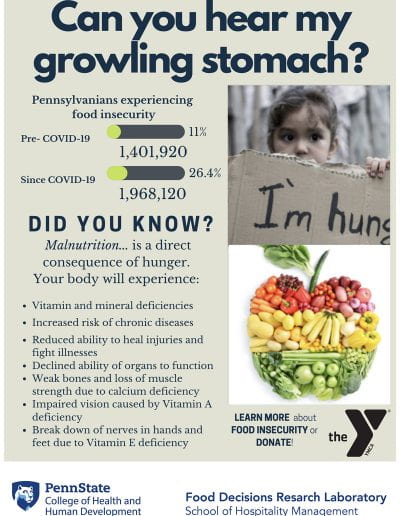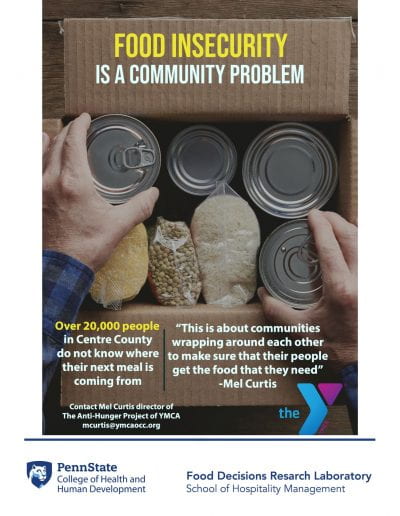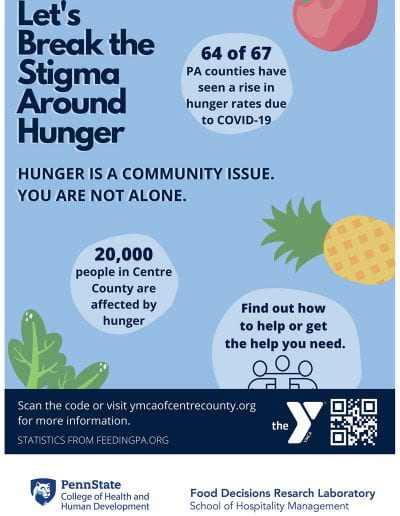ALLEVIATING
PANDEMIC-RELATED
HUNGER CLOSE TO HOME
In the spring of 2020, many members of the Penn State community were searching for ways to alleviate the suffering that people faced due to the COVID-19 pandemic and its attendant shutdowns.
ALLEVIATING
PANDEMIC-RELATED
HUNGER CLOSE TO HOME
In the spring of 2020, many members of the Penn State community were searching for ways to alleviate the suffering that people faced due to the COVID-19 pandemic and its attendant shutdowns.
The Penn State community vs. food insecurity
Researchers in the Food Decisions Research Laboratory in Penn State’s School of Hospitality Management studied how the global shutdown was affecting food supply chains and stable access to food. They recruited a cohort of ten Penn State undergraduate students who also wanted to reduce suffering.
The students spent summer 2020 calling individuals across the Philadelphia area who were connected to services through Penn State Center Outreach Philadelphia. The students gathered information about who was struggling with food insecurity. Using this process, the students identified many more people suffering from pandemic-related food insecurity and provided a more accurate picture of the scope and scale of the problem.
For Natalie Gretsch, who graduated in spring 2021 with a degree in hospitality management, the work broadened her understanding of the problem of food insecurity.
“When I started making these phone calls,” Gretsch said, “like a lot of people, I did not have a true or wide-enough understanding of what food insecurity is. People have images in their head of extreme poverty or homelessness. And while that is real, the problem of food insecurity is bigger than that.”
“In our group, we discussed the concept of ‘new hunger,’” Gretsch continued. “A person may have just purchased a car, but if they do not have enough left to feed themselves, they can struggle with food insecurity. You never know who is going through hunger. It could be your neighbors; hunger does not simply match the image in your head.”
When Penn State’s fall 2020 semester began, more students were eager to become involved, so the researchers contacted local organizations to learn what could be accomplished in the community. As a result, they developed two projects that allowed the students to combat suffering in Centre County: an interactive free-and-reduced-cost-meal map and anti-hunger information flyers.
Map of free and reduced cost meals
The research team decided to create a digital, visual map that allows people to see what free and reduced-cost food is available across Centre County. The students contacted many local non-profits, food banks, and other relevant organizations to identify sources of free and reduced-cost food.
“Maps in this style exist in other parts of the country, like Philadelphia,” explained Amit Sharma, professor of hospitality management and leader of the project. “But we wanted to create a map for Centre County. Eventually, we plan to scale this up to include a broader region.”
Author
Aaron
Wagner
The students gather information about where food opportunities are located including eligibility, availability, and pickup information. Then, this information is added to a database and used to generate an interactive map that allows people to learn about available food resources. In the future, student volunteers will continue to work on the map to make sure that the listed resources remain up to date.
“There are so many food banks and food distributions in Centre County,” said Madeline Polkinghorn, a senior majoring in Nutritional Sciences. “I am very proud of my community and the number of resources available. I hope to continue to build awareness of food insecurity, so people feel more welcome to reach out and get help.”
Despite the number of options available, food insecurity remains an issue in Centre County, as does the stigma associated with seeking food when people are in need.
YMCA anti-hunger informational flyers
The YMCA of Centre County has been conducting a large, anti-hunger campaign that has welcomed student volunteers for years. During the pandemic, students created a series of informational flyers about local food insecurity.
The flyers are a tool for educating people in Centre County about the local crisis. Community members who are not facing food insecurity can learn about the scope of the problem and how to support those in need. Community members who are facing food insecurity can learn how to get help and that they are not alone in their struggles.
“Food insecurity started growing as soon as the pandemic started affecting people’s jobs, and—quite frankly—it has not stopped. The number of people who we provide services to continues to grow,” said Mel Curtis, director of the YMCA of Centre County’s Anti-Hunger Program. “Prior to COVID, one in every seven children we were seeing faced food insecurity. Since COVID arrived, it is one in four. We anticipate it will take six to seven years to reach pre-COVID food insecurity levels. When you start to look at those numbers, you’re talking about thousands of people in Centre County.”
The flyers document the scope of the problem. The rate of food insecurity in Pennsylvania more than doubled during the COVID-19 pandemic. In 2018, 11 percent of Pennsylvanians experienced food insecurity. In 2020, that number was greater than 26 percent. Food insecurity affects 20,000 people in Centre County alone.
Growth and Learning
Many of the student volunteers were exuberant about their research and community service experience.
Tess O’Callaghan, a recent graduate with a degree in hospitality management, worked on the food-resource map during her senior year. Hospitality Management students are required to accrue 1,000 hours of industry-relevant professional experience. For O’Callaghan and other seniors, completing the 1,000-hour requirement was difficult because many jobs and internships were shut down during the pandemic. O’Callaghan initially got involved in the project to fulfill the requirement, but she quickly became passionate about the work.
“I had no idea that there were so many people in Centre County who struggled with food insecurity,” O’Callaghan said. “Throughout my life, my parents tried to foster a sense of gratitude and service in me. I previously participated in food drives and other charity events, but I never felt like I was a part of something that is going to make a lasting difference. Knowing that there are real people in this area who are going to be helped by the map we created, that makes me feel fulfilled and hopeful. The experience exceeded my expectations and even my hopes, and it is great to contribute to something that is more than just a project for a class.”
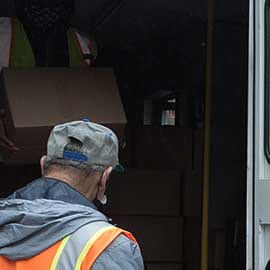
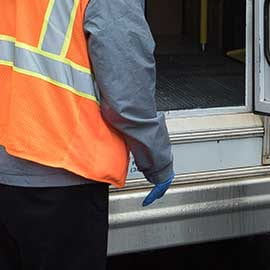
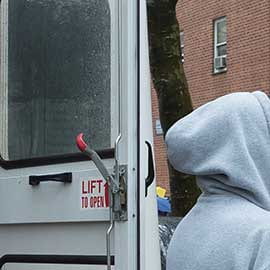
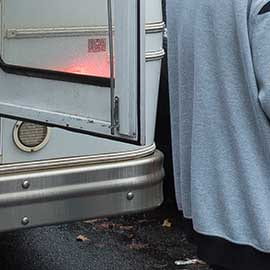
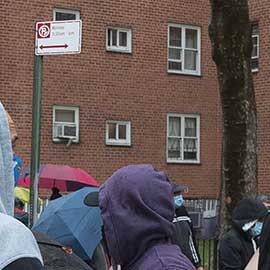
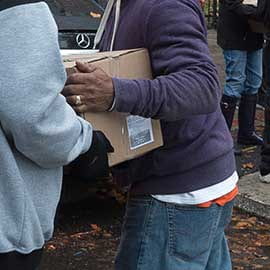

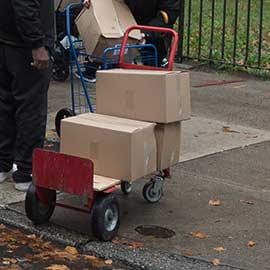
In cities and rural areas, food insecurity silently afflicts thousands and thousands of Pennsylvanians.



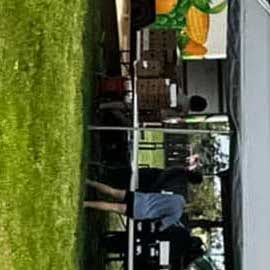



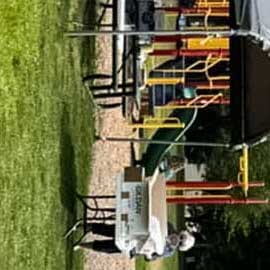
From cities
Students gathered information about who was struggling with food insecurity in Philadelphia. Using this process, the students were able to identify many more people suffering from pandemic-related food insecurity and provide a more accurate picture of the scope and scale of the problem.
To Centre County
When Penn State’s fall 2020 semester began, more students were eager to become involved, so the researchers contacted local organizations to learn what could be accomplished in the community. As a result, they developed two projects that allowed the students to combat suffering in Centre County: an interactive free-and-reduced-cost-meal map and anti-hunger information flyers.
“Undergraduate research never felt accessible to me,” Ashner said. “This opportunity changed my entire perspective on my education and fulfilled a need in me that I did not know that I had. I hope the program continues so that other undergraduate students have the same opportunities that I did.”
Ashner also said that this experience inspired her to try and incorporate service work into her future career.
“I have always loved sports,” Ashner explained, “In my dream job, I would work in community-relations for a sports team. I would love to help give back to communities that don’t have resources or to bring access to sports in general to different communities. And now, I will always keep an eye toward addressing food insecurity in communities. My goal is to give back and to continue to grow and learn as a person.”
Kimberly Impellitteri, research project coordinator for the Food-Decisions Research laboratory, has been impressed with the students’ enthusiasm, dedication, and problem-solving.
“I had the privilege of working with the students from beginning to end on these projects,” Impellitteri said. “It was exciting to see their enthusiasm grow as they learned more about food insecurity and how to address the problem. Some have even gone on to volunteer to help fight food insecurity beyond this project. We are all very proud of the hard work the student put into completing these projects.”
Local steps to address a global problem
Though the growth experienced by student participants is one of the most immediate impacts of the work, the steps to address the issue of food insecurity will be the longest lasting.
“In March of 2020, my colleagues and I were feeling sort of helpless in the face of the pandemic,” said Sharma. “We knew we had to do something and decided to do an assessment of food safety and security. In academia, there is always a need to determine what you will produce and publish. But we decided, ‘we are going to worry about that later this time.’ Let’s just jump in and help people. The scholarship will come in time.”
Donna Quadri-Felitti, Marvin Ashner Endowed Director and Associate Professor, School of Hospitality Management, sees this work as central to the mission of the department.
Chandler Yu also contributed to this research.
Penn State addresses food security
Penn State has taken on a number of initiatives to further identify and support student needs, develop programs for food insecurity prevention and response, and advocate for policies at local, state, and federal levels.
- Enhancements at campus food pantries, including the Lion’s Pantry.
- A digital, visual map to find free and reduced-cost food across Centre County, created by the Food Decisions Research Lab in the School of Hospitality Management.
- Additional need-based student aid through the Renaissance Fund Scholarships and the new LiveOn Student Success Grant program.
- Continued partnership with Swipe Out Hunger.
Photo Credits
Top photo: Getty Images (SDI Productions)
Photo behind “A grocery job led student to anit-hunger advocacy” callout: Getty Images (Hispanolistic)
Student Created Poster images: Penn State’s Food Decisions Research Laboratory
Photo of men unloading boxes: Getty Images (Massimo Giachetti)
Photo of Food Drive: Courtesy of Centre County YMCA
Photo behind “The cost of worrying about your next meal”: Credit Getty Images (LightFieldStudios)
Author
Aaron Wagner
Discover More
Research Impact
No Results Found
The posts you requested could not be found. Try changing your module settings or create some new posts.
In the News
No Results Found
The posts you requested could not be found. Try changing your module settings or create some new posts.
Student Experience
No Results Found
The posts you requested could not be found. Try changing your module settings or create some new posts.
Health Disparities
No Results Found
The posts you requested could not be found. Try changing your module settings or create some new posts.


